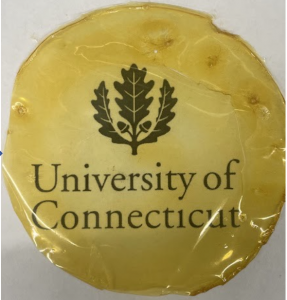The Future of Fashion
Can We Make New Plastics Out of Old Clothes?
A UConn chemistry researcher is the future of fashion.
Professor Emeritus Challa Kumar was “fed up” with the tremendous amount of plastic and cloth waste generated annually around the globe. So Kumar and his team leveraged their expertise to repurpose waste from fashion, one of the world’s most polluting industries, to create a biodegradable alternative to plastic, one of the world’s most polluting substances.

“Everyone should think about replacing fossil fuel-based materials with natural materials anywhere they can to help our civilization to survive,” Kumar says. “The house is on fire, we can’t wait. If the house is on fire and you start digging a well — that is not going to work. It’s time to start pouring water on the house.”
Kumar has developed two technologies to create new, plastic-like materials: one that uses proteins, and one that uses proteins reinforced with cloth fibers. UConn’s Technology Commercialization Services (TCS) has filed provisional patents for both.
“Chemistry is the only thing standing in our way,” Kumar says. “If we understand protein chemistry, we can make protein materials as strong as a diamond or as soft as a feather.”
Kumar’s process creates a novel 3D structure that allows the new polymers to behave like plastic. Just like the proteins from which it is made, the material can stretch, change shape, and fold. Unlike synthetic polymers, however, Kumar’s new material can biodegrade the way animal and plant proteins do naturally.
The team continues to test the materials’ strength, flexibility, and toxicity, as well as what happens to the materials when they are buried in the ground, which is where many post-consumer plastics end up. The group has demonstrated several uses for both technologies, creating coffee cup lids and thin transparent films made from the protein-based material and small shoes, flowers, and chairs made from the protein-fiber composites.
“We are creating a lot of textile waste each year due to the fast-changing fashion industry,” Kumar says. “So why not use that waste to create useful materials — convert waste to wealth.”
Learn more about the science behind Kumar’s plastic alternatives.
400 million tons of plastic waste
92 million tons of cloth waste
Generated Annually Worldwide

Big ideas come from out of the blue.
Behind every breakthrough, there’s a story of creativity and commitment. One where individuals come together, fueled by a shared vision and sustained by imagination and persistence.



